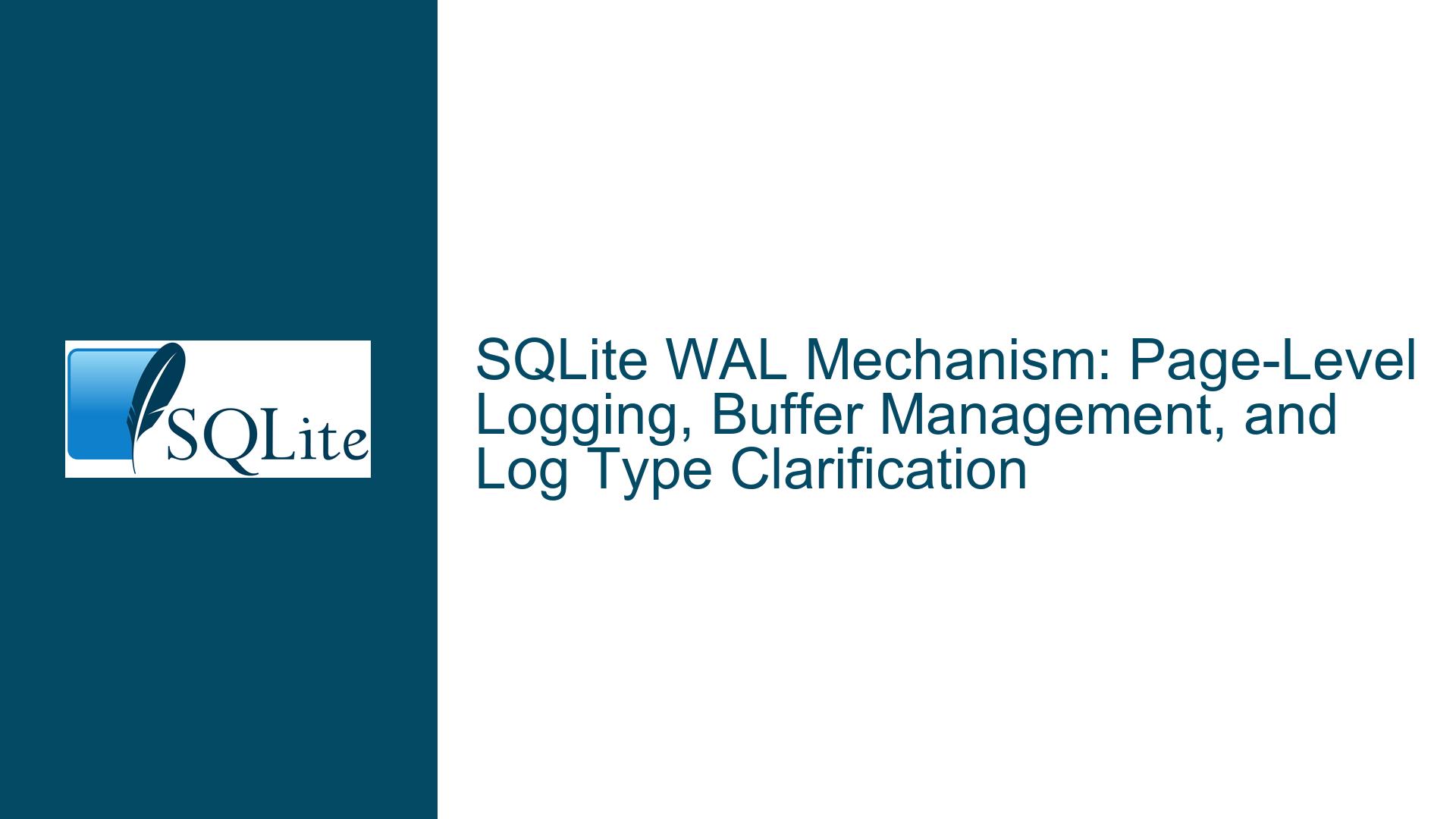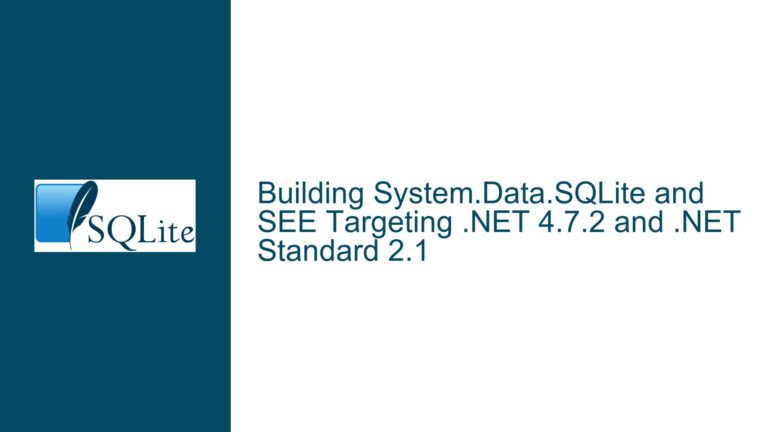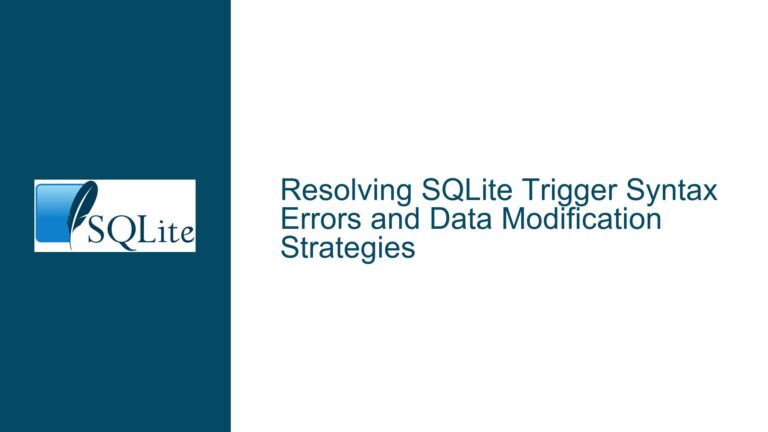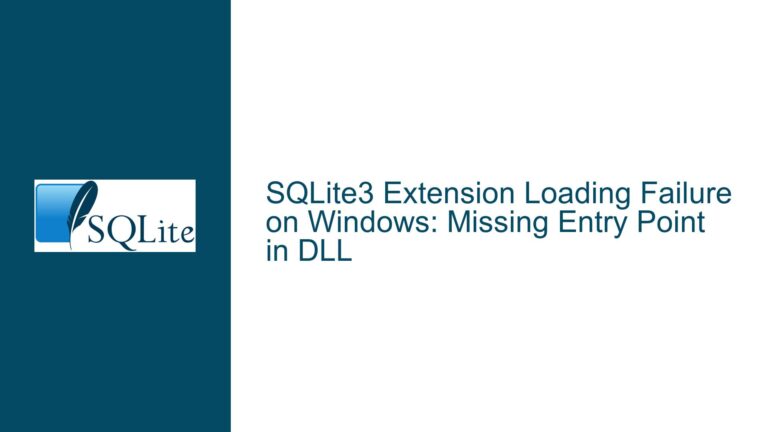SQLite WAL Mechanism: Page-Level Logging, Buffer Management, and Log Type Clarification
Understanding SQLite WAL’s Page-Level Logging, Buffering Strategy, and Log Type Behavior
Issue Overview: Core Questions About WAL’s Data Volume, Buffering, and Log Semantics
The SQLite Write-Ahead Logging (WAL) mechanism introduces a performance-optimized approach to transaction management by decoupling write operations from read operations. However, its implementation raises critical questions about its design philosophy, operational efficiency, and recovery semantics.
Page-Level Logging vs. Redo Record Efficiency
A central concern revolves around why SQLite WAL writes entire modified database pages to the WAL file instead of smaller redo records. Traditional database systems often use redo logs that capture only incremental changes, reducing I/O volume. SQLite’s approach appears counterintuitive at first glance, as writing full pages increases WAL file size. However, this design simplifies read consistency: readers accessing the database during ongoing transactions can directly fetch the latest page versions from the WAL without reconstructing fragmented redo entries. This eliminates the need for complex page-stitching logic during reads, reducing latency and computational overhead.In-Memory Buffering for WAL Operations
Another key question involves whether SQLite employs in-memory buffers for WAL records before writing them to disk. While SQLite does not maintain a dedicated WAL buffer, it uses a page cache to hold modified pages in memory until transactions commit. This cache acts as an implicit buffer, allowing SQLite to batch page modifications and minimize disk I/O. Changes are only written to the WAL file when a transaction commits or the cache exceeds its configured size (controlled byPRAGMA cache_size). This approach balances memory usage and write amplification.WAL as Redo, Undo, or Hybrid Log
SQLite’s WAL does not fit neatly into the traditional redo/undo log dichotomy. Unlike undo logs, which store pre-modification page states to roll back uncommitted transactions, or redo logs, which store post-modification states to replay committed transactions, SQLite’s WAL acts as a page replacement log. Committed transactions append modified pages to the WAL, which are later transferred to the main database during checkpoints. Uncommitted transactions leave no trace in the WAL if rolled back, as their pages are never flushed.Inspecting and Interpreting WAL Files
SQLite does not provide built-in tools for WAL file introspection, but the WAL file format is publicly documented. Third-party utilities and custom scripts can parse WAL files to extract transaction metadata, page versions, and checkpoint markers. This capability is crucial for debugging data corruption, analyzing transaction patterns, or validating recovery workflows.
Design Rationale and Operational Constraints Driving WAL’s Behavior
1. Page-Level Logging: Tradeoffs Between I/O Volume and Read Simplicity
Cause 1: Read Consistency Without Locking Overheads
SQLite’s WAL prioritizes read consistency by allowing concurrent readers to access the latest committed data directly from the WAL. If the WAL stored only redo records, readers would need to reconstruct pages by applying these records to the main database, which might not reflect the latest state due to uncheckpointed changes. Full-page logging ensures that any reader can access the exact page version as of their read timestamp without coordinating with writers.
Cause 2: Avoiding Page Versioning Complexity
Storing full pages simplifies crash recovery and checkpointing. During recovery, SQLite replays WAL pages directly to the main database without parsing redo operations. Similarly, checkpoints involve bulk page copies rather than incremental updates. While this increases WAL file size, it reduces computational complexity and eliminates edge cases where redo records depend on specific page states.
Cause 3: Alignment with SQLite’s Embedded Use Case
SQLite is designed for embedded systems with limited computational resources. Full-page logging reduces CPU overhead during writes and recovery, even at the cost of higher storage usage. For most applications, WAL file size remains manageable due to frequent checkpoints and the transient nature of WAL content.
2. Buffering Strategy: Delayed WAL Writes to Optimize I/O
Cause 1: Transactional Atomicity and the Commit Boundary
SQLite delays writing WAL records until transactions commit to ensure atomicity. If a transaction aborts, its in-memory page changes are discarded without ever touching the WAL. Writing to the WAL at commit time minimizes disk I/O for rolled-back transactions and avoids polluting the WAL with unused data.
Cause 2: Page Cache as a Write Buffer
The page cache (managed via PRAGMA cache_size) serves as a de facto buffer for WAL-bound pages. Modified pages accumulate in memory until the cache fills or a commit forces a flush. This reduces the number of small, random writes to the WAL file, which is critical for performance on mechanical disks or flash storage with high write amplification.
Cause 3: OS Page Cache Interaction
SQLite relies on the operating system’s page cache to further buffer writes. When a transaction commits, SQLite writes WAL records to the OS cache, not directly to disk. The PRAGMA synchronous setting determines when these writes are flushed to physical storage. This defers disk I/O to the OS, leveraging its efficient buffering mechanisms.
3. Log Semantics: Page Replacement Over Redo/Undo
Cause 1: Simplifying Rollback and Recovery
By treating the WAL as a log of page replacements, SQLite avoids maintaining separate undo data for rollbacks. Uncommitted transactions exist only in the page cache and are discarded on rollback. Committed transactions are irrevocably appended to the WAL, making recovery a matter of reapplying WAL pages to the main database.
Cause 2: Checkpoint-Driven Storage Reclamation
WAL files grow until a checkpoint occurs, transferring pages to the main database. This design avoids fragmentation in the main database file, as checkpoints write pages in contiguous blocks. It also simplifies storage management: the WAL file’s size is self-regulating through checkpoints, unlike traditional redo logs that require circular buffering or archival.
Cause 3: No Support for Flashback or Historical Queries
SQLite’s WAL does not support querying historical database states, as it lacks undo data to reconstruct past versions. This aligns with its use cases, where point-in-time recovery and flashback queries are uncommon. The WAL’s design assumes that once a checkpoint completes, all prior versions are obsolete.
Resolving WAL-Related Issues: Configuration, Optimization, and Diagnostics
1. Mitigating WAL File Bloat and Checkpoint Pressure
Solution 1: Tune Checkpoint Frequency and Aggressiveness
- Use
PRAGMA wal_autocheckpointto adjust the threshold for automatic checkpoints (e.g.,PRAGMA wal_autocheckpoint=1000;triggers a checkpoint when the WAL reaches 1000 pages). - For write-heavy workloads, manually invoke
PRAGMA wal_checkpoint(TRUNCATE);to force checkpoints and truncate the WAL file. - Monitor WAL size using
sqlite3_wal_checkpoint_v2()in applications to prevent unbounded growth.
Solution 2: Optimize Page Cache and Synchronization Settings
- Increase
PRAGMA cache_sizeto reduce WAL write frequency, allowing more pages to accumulate in memory before spilling to disk. - Set
PRAGMA synchronous=NORMALfor workloads tolerant of rare data loss, reducing flush operations. AvoidFULLunless absolute durability is required.
Solution 3: Limit Long-Running Read Transactions
Long-running readers prevent checkpoint truncation by maintaining a read-mark in the WAL. Design applications to avoid holding read transactions open indefinitely.
2. Diagnosing WAL Buffer Management and I/O Patterns
Solution 1: Profile Page Cache Utilization
Use sqlite3_status(SQLITE_STATUS_PAGECACHE_USED, ...) to track page cache usage. High utilization indicates frequent cache spills to WAL, necessitating a larger cache.
Solution 2: Trace WAL Write Patterns
Enable SQLite’s I/O logging via sqlite3_trace_v2() to capture WAL write timings and sizes. Correlate with transaction commit rates to identify I/O bottlenecks.
Solution 3: Leverage OS-Level Monitoring
Tools like iotop (Linux) or Process Monitor (Windows) can observe SQLite’s write patterns to the WAL file, distinguishing between OS cache flushes and physical disk writes.
3. Interpreting WAL Files for Debugging and Forensics
Solution 1: Parse WAL Files Using Custom Tools
The WAL file format is documented at SQLite File Format. Use a hex editor or custom parser to extract:
- Frame Header: Transaction metadata (e.g., commit flags, salt values).
- Page Data: Modified pages with their original database page numbers.
- Checksums: Validate integrity using the header’s checksum fields.
Solution 2: Utilize Third-Party WAL Analyzers
Tools like wal2json decode WAL files into human-readable JSON, mapping page changes to logical operations.
Solution 3: Reconstruct Database State from WAL
Combine the main database file with the WAL file using PRAGMA wal_checkpoint(FULL); to force a checkpoint, then analyze the resulting database. For corrupted databases, use .recover in the sqlite3 CLI to salvage data.
4. Addressing Misconceptions About WAL’s Log Type
Solution 1: Clarify WAL’s Role in Crash Recovery
Educate developers that SQLite’s WAL is not a traditional redo log. Instead, it serves as a staging area for committed pages, which are atomically transferred to the main database during checkpoints.
Solution 2: Contrast with Undo Logging
Highlight that SQLite’s rollback journal (non-WAL mode) uses undo logging, whereas WAL mode entirely replaces this with a commit-time page log. Undo data is unnecessary in WAL mode because uncommitted transactions never write to the WAL.
Solution 3: Document Recovery Semantics
Formalize recovery procedures:
- WAL Mode Recovery: Reapply all WAL frames since the last checkpoint.
- Rollback Journal Recovery: Undo uncommitted changes using journaled pre-images.
By addressing these facets—page logging tradeoffs, buffering mechanics, and log semantics—developers can optimize SQLite deployments, diagnose performance issues, and leverage WAL’s strengths effectively.






